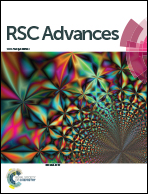A novel cyclometalated Ir(iii) complex based luminescence intensity and lifetime sensor for Cu2+†
Abstract
We report the synthesis and characterization of two luminescent cyclometalated Ir(III) complexes [Ir(dfppy)2(bpy-DPA)]PF6 (Ir-1) and [Ir(dfppy)2(bpy-BiDPA)]PF6 (Ir-2), where dfppy, bpy-DPA and bpy-BiDPA represent 2-(2,4-difluorophenyl)pyridine, N-([2,2′-bipyridine]-4-yl)-2-(bis(pyridin-2-ylmethyl)amino)acetamide and N,N′-([2,2′-bipyridine]-4,4′-diyl)bis(2-(bis(pyridin-2-ylmethyl)amino)acetamide), respectively. Their photophysical properties and sensing properties towards various metal ions were investigated at room temperature. The two complexes both possessed good photophysical properties, and Ir-2 had quite a high quantum yield (93.83%) and a long lifetime (101.17 μs), which is impressive among Ir(III) complexes. Ir-2 exhibited both high selectivity and sensitivity towards Cu2+ over other metal ions. The Job curve and mass spectra suggested the formation of a 1 : 2 bonding mode between Ir-2 and Cu2+. The photoluminescence (PL) intensity quenching curve indicated that Ir-2 could enable rapid and reversible detection of Cu2+ with a low detection limit of 0.85 ppb (13 nM). Furthermore, a linear relationship could be observed between the PL lifetime value of Ir-2 and the concentration of Cu2+ ions in the range of 0–8 μM. These results suggested that Ir-2 might have use as not only a promising photoluminescence intensity sensor, but also a promising lifetime sensor for Cu2+ in aqueous solution.


 Please wait while we load your content...
Please wait while we load your content...